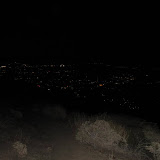On the day of the climb, we were up at 02:45; out of the condo by 03:30 and at the Lyken trail head with our lamps on at exactly 04:30. The crystal clear view of cities below in the darkness of night was breathtaking. We made the Skyline junction by sunrise at 05:30 and packed away the headlamps. Being our first time on the Skyline trail, we took our time from this point. The climbing never really ended. There were hundreds if not thousands of short little switchbacks that each claimed another few feet of elevation. This is the mental kind of hiking where you just keep picking them up and putting them down, not long strides, but lots of short steps that don’t drain the muscles, but work the heart. We settled for lunch and a catnap on a big flat rock overlooking the valley at around 10:00am. It was at this point that I had consumed 100oz. of my water and shifted to a new source. We headed back up the trail at around 10:48 and once again resumed the zombie shuffle. Soon we could see the alpine zone in the distance, but it took many more hilltops to crest before we were actually on the fringe of the alpine zone. Coffman’s Crag looked close, but we knew differently. At least it was a landmark that would prompt our bid for the “Notch” when it was eventually reached. I was extremely happy to touch my first pine tree. Climbing in the alpine zone was challenging due to the new spring growth choking the trail. We reached the snow chutes prior to Coffman’s and did have some route finding issues. There was a lot of evidence of people scrambling for a trail. I can only say, use and trust your instrumentation, or backtrack to the known route and don’t budge until a proper route is identified going forward. The tricky part was that in some cases, the snow was only on the trail, masking the trail in some parts and in some cases masking a direction change. The most common mistake noted from all the tracks was that people were looking down when they should have been looking up for the next section of trail. After 45 minutes of route finding, we finally found the safe route to Coffmans, which had only been 1500 feet from our location. It is not a matter of knowing where you are, it’s a matter of finding a safe route from where you are to where you need to be. We reached the notch at 16:15 and were drinking root beer and Corona’s at 16:45. A quick tram ride down, a twenty-five dollar taxi ride and we were back at the end of Ramon road, in the Jeep on our way back home. Apart from the elevation of Mt. Whitney, this has been the most demanding of our adventures thus far.
Picture are located at the link below.
 |
| 2010 05 12 Cactus to Clouds Hike |
Information can be found at:
http://www.nationalgeographic.com/adventure/hiking/best-trails-andrew-skurka.html
and at:
http://www.geocities.com/cactus2clouds/skyline.html





























